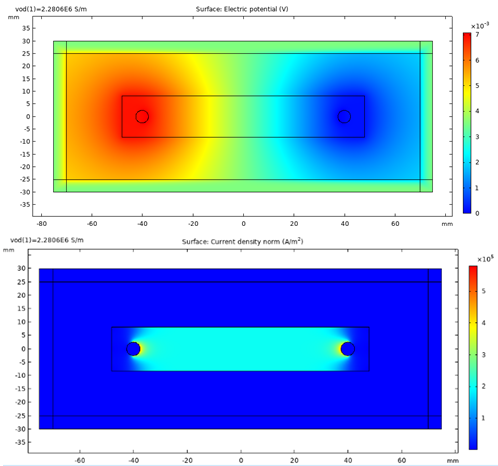Estimation of electrical resistivity of conductive materials of random shapes
DOI:
https://doi.org/10.20998/2074-272X.2023.6.13Keywords:
electrical resistivity, finite element method, electrical resistivity measurements, numerical simulationAbstract
Introduction. Electrical resistivity is an important material characteristic in the field of electrical engineering and material science. There are several methods that can be used to measure resistance, like the 4-wire method which relates the resistance to a voltage drop at a given current flow, but to define the resistivity from the resistance value requires an analytical expression for the given system which requires a sufficient mathematical apparatus for describing complicated shapes. Therefore we use finite element method computations to compute the resistivity of a metal material. This approach has been already used for different materials like concrete and aluminum in the past. We then compare this method with an analytical expression that due to intuition could approximate the solution sufficiently. After that, the same material is used again to test the electrical isotropy of the sample. Novelty. A method is developed by combining the results of experimental studies and the results of mathematical modelling of the process of determining the electrical conductivity of metals. The goal is to describe and employ a method of measuring the electrical resistivity of metal objects of random shapes. Using this method, it is possible to measure the resistivity of materials without the need to manufacture them into wires or ribbons. Methods. The solution to the problem was carried out by the finite element method via the COMSOL Multiphysics 5.6 simulation program in a cartesian coordinate system and the resistance between two points of the metal sample was measured by the 4-wire method. Results. A similar resistance value was obtained when the measuring terminals were placed in different places. The difference between them was within 1,5 % and the obtained values were close to the values given by the literature for the electrical resistivity of electrical steels. Terminal size influences the measured conductivity and a max error of 5,2 % was estimated. Practical value. A method of estimating the resistivity of materials without the need to manufacture them into specific shapes, like wires or ribbons, for which analytical expressions between resistivity and resistance are easily derived.
References
Singh Y. Electrical resistivity measurements: a review. International Journal of Modern Physics: Conference Series, 2013, vol. 22, pp. 745-756. doi: https://doi.org/10.1142/S2010194513010970.
Zimmerman J.E. Measurement of Electrical Resistivity of Bulk Metals. Review of Scientific Instruments, 1961, vol. 32, no. 4, pp. 402-405. doi: https://doi.org/10.1063/1.1717387.
Rossiter P.L. The Electrical Resistivity of Metals and Alloys. Cambridge Solid State Science Series, 1991. 452 p.
Hájek M., Veselý J., Cieslar M. Precision of electrical resistivity measurements. Materials Science and Engineering: A, 2007, vol. 462, no. 1-2, pp. 339-342. doi: https://doi.org/10.1016/j.msea.2006.01.175.
Zhang D. Magnetic skin effect in silicon-iron core at power frequency. Journal of Magnetism and Magnetic Materials, 2000, vol. 221, no. 3, pp. 414-416. doi: https://doi.org/10.1016/S0304-8853(00)00414-5.
Wilmot-Smith A.L., Priest E.R., Hornig G. Magnetic diffusion and the motion of field lines. Geophysical & Astrophysical Fluid Dynamics, 2005, vol. 99, no. 2, pp. 177-197. doi: https://doi.org/10.1080/03091920500044808.
Sengul O., Gjorv O.E. Effect of Embedded Steel on Electrical Resistivity Measurements on Concrete Structures. ACI Materials Journal, 2009, vol. 106, no. 1, pp. 11-18. doi: https://doi.org/10.14359/56311.
Liang S., Du H., Zou N., Chen Y., Liu Y. Measurement and simulation of electrical resistivity of cement-based materials by using embedded four-probe method. Construction and Building Materials, 2022, vol. 357, art. no. 129344. doi: https://doi.org/10.1016/j.conbuildmat.2022.129344.
Azarsa P., Gupta R. Electrical Resistivity of Concrete for Durability Evaluation: A Review. Advances in Materials Science and Engineering, 2017, vol. 2017, art. no. 8453095. doi: https://doi.org/10.1155/2017/8453095.
Ma X., Peyton A.J., Zhao Y.Y. Eddy current measurements of electrical conductivity and magnetic permeability of porous metals. NDT & E International, 2006, vol. 39, no. 7, pp. 562-568. doi: https://doi.org/10.1016/j.ndteint.2006.03.008.
Liu X., Sun J., Wang H. Numerical simulation of rock electrical properties based on digital cores. Applied Geophysics, 2009, vol. 6, no. 1, pp. 1-7. doi: https://doi.org/10.1007/s11770-009-0001-6.
Nakamichi I. Electrical Resistivity and Grain Boundaries in Metals. Materials Science Forum, 1996, vol. 207-209, pp. 47-58. doi: https://doi.org/10.4028/www.scientific.net/MSF.207-209.47.
Montgomery H.C. Method for Measuring Electrical Resistivity of Anisotropic Materials. Journal of Applied Physics, 1971, vol. 42, no. 7, pp. 2971-2975. doi: https://doi.org/10.1063/1.1660656.
OpenStax. 9.3 Resistivity and Resistance. University Physics, 2023, vol. 2. Available at: https://openstax.org/books/university-physics-volume-2/pages/9-3-resistivity-and-resistance (accessed 01 March 2023).
COMSOL Multiphysics Cyclopedia, Electrostatics, Theory. 2023. Available at: https://www.comsol.com/multiphysics/electrostatics-theory?parent=electromagnetics-072-162 (accessed 01 March 2023).
Kováč D., Kováčová I., Kaňuch J. EMC z hlediska teorie a aplikace. Praha, BEN technická literatura, 2006.
COMSOL Multiphysics Cyclopedia, Steady Currents. 2023. Available at: https://www.comsol.com/multiphysics/steady-currents?parent=electromagnetics-072-502 (accessed 01 March 2023).
Taylor R.J. An Introduction to Error Analysis: The Study of Uncertainties in Physical Measurements. 2nd Edition. University Science Books, 1996. 327 p.

Downloads
Published
How to Cite
Issue
Section
License
Copyright (c) 2023 Š. Gans, J. Molnár, D. Kováč

This work is licensed under a Creative Commons Attribution-NonCommercial 4.0 International License.
Authors who publish with this journal agree to the following terms:
1. Authors retain copyright and grant the journal right of first publication with the work simultaneously licensed under a Creative Commons Attribution License that allows others to share the work with an acknowledgement of the work's authorship and initial publication in this journal.
2. Authors are able to enter into separate, additional contractual arrangements for the non-exclusive distribution of the journal's published version of the work (e.g., post it to an institutional repository or publish it in a book), with an acknowledgement of its initial publication in this journal.
3. Authors are permitted and encouraged to post their work online (e.g., in institutional repositories or on their website) prior to and during the submission process, as it can lead to productive exchanges, as well as earlier and greater citation of published work.




